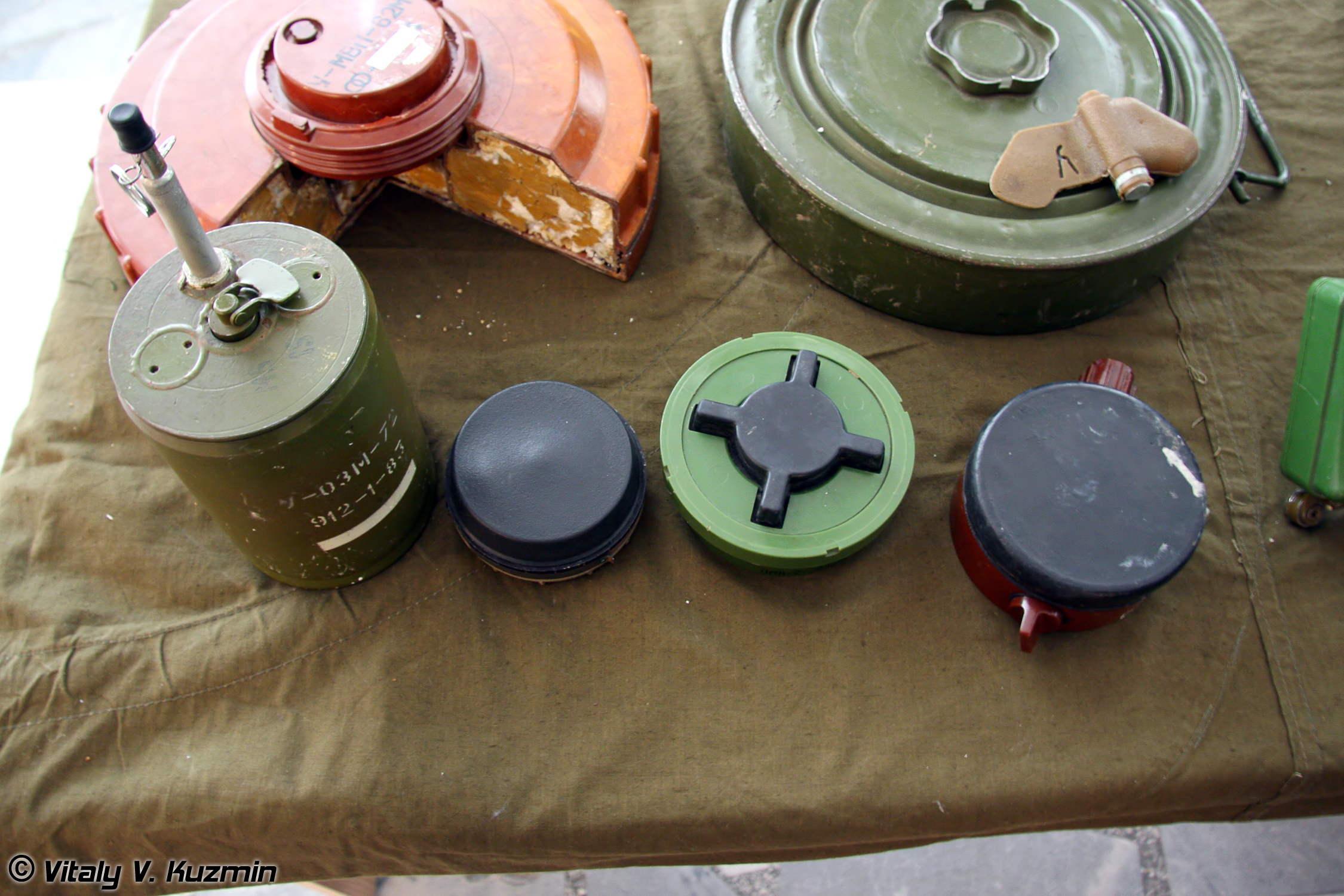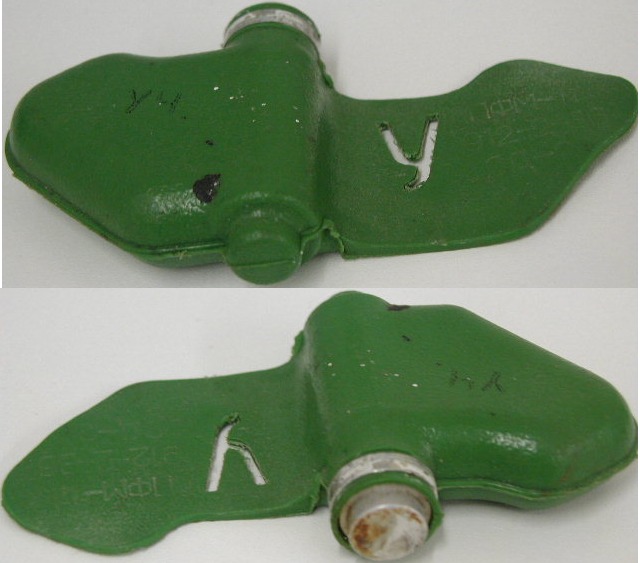|
TM-83 Mine
The TM-83 is a Soviet off-route shaped charge anti-tank mine, first shown publicly in 1993, and developed in 1983. The mine consists of a large Misznay Schardin effect warhead and is actived using its infra-red and seismic sensors. Deployment The mine can be installed on soil, or be attached to various objects only manually. The mine is generally positioned 5 meters from the road, and it is intended to attack and aimed using an integrated sight. The TM-83 can be deployed in two operation modes – autonomous or controlled. The primary difference is that the controlled version has a 100-meter-long wire attached, allowing the operator to switch it through its various modes repeatedly (safe or active, see ). If the mine is controlled, it can be switched to its safety mode and be easily removed; however, if the mine is in its autonomous mode, it is considered impossible to remove due to the high sensitivity of the seismic sensor and the chance that the mine will be set off by the ... [...More Info...] [...Related Items...] OR: [Wikipedia] [Google] [Baidu] |
Machine Gun
A machine gun is a fully automatic, rifled autoloading firearm designed for sustained direct fire with rifle cartridges. Other automatic firearms such as automatic shotguns and automatic rifles (including assault rifles and battle rifles) are typically designed more for firing short bursts rather than continuous firepower, and are not considered true machine guns. As a class of military kinetic projectile weapon, machine guns are designed to be mainly used as infantry support weapons and generally used when attached to a bipod or tripod, a fixed mount or a heavy weapons platform for stability against recoils. Many machine guns also use belt feeding and open bolt operation, features not normally found on other infantry firearms. Machine guns can be further categorized as light machine guns, medium machine guns, heavy machine guns, general purpose machine guns and squad automatic weapons. Similar automatic firearms of caliber or more are classified as autocannons, rat ... [...More Info...] [...Related Items...] OR: [Wikipedia] [Google] [Baidu] |
PTM-3 Mine
The PTM-3 ( Russian: ПТМ-3: ПротивоТанковая Мина-3) is a Soviet scatterable self-liquidating shaped charge anti-tank mine. The mine's case is made up of a stamped steel body with notches in its side. The notches allow the mine to produce a shaped charge effect on five sides - 4 on the sides, and one on the end face. The mine has two arming stages - pyrotechnic and mechanical, and has a magnetic influence battery-powered fuze BT-06 ( Russian: БТ-06). The mine can be delivered using the BM-30 Smerch (9M55K4), BM-27 Uragan (9M59), BM-21 Grad (9M22K) MLRS, helicopter-mounted minelaying system VSM-1, remote mining machine UMZ ( Russian: УМЗ) or portable mining kit PKM ( Russian: ПКМ: Переносной Комплект Минирования). It cannot be placed manually, and must only be placed using remote minelaying systems listed above. Action The mine can only be deployed on soil with the use of various minelaying systems, within the KPTM-3 cass ... [...More Info...] [...Related Items...] OR: [Wikipedia] [Google] [Baidu] |
PMN Mine
The PMN () series of blast anti-personnel mines were designed and manufactured in the Soviet Union. They are one of the most widely used and commonly found devices during demining operations. They are sometimes nicknamed "black widow" because of their dark casings. PMN-1 The design of the PMN-1 mine dates from the late 1950s. It is particularly deadly because it contains an unusually large explosive filling when compared to most other anti-personnel landmines. For comparison, most anti-personnel blast mines (e.g. the VS-50) contain around 50 grams of high explosive, which typically destroys all or part of a victim's foot. In marked contrast, a PMN-1 contains 249 grams of explosive which can easily destroy a victim's entire leg (frequently requiring amputation high above the knee) in addition to inflicting severe injuries on the adjacent limb, which may also require some form of amputation due to blast injury. The majority of anti-personnel mine victims (e.g. those who step on an ... [...More Info...] [...Related Items...] OR: [Wikipedia] [Google] [Baidu] |
PFM-1
PFM-1 () is a scatterable high explosive anti-personnel land mine of Soviet and Russian production. It is also known as a Green Parrot or Butterfly Mine. The mines can be deployed from mortars, helicopters and aeroplanes in large numbers; they glide to the ground without exploding and will explode later upon contact. Design The mine consists of a polyethylene plastic container containing 40 g of explosive liquid. The two wings of the PFM-1 allow it to glide after being released in the air, then spin, stabilising it and slowing its descent. The thick wing contains the liquid explosive. The two wings together are 120 mm (about 5 inches) long. The plastic body can be moulded in a variety of colours for best camouflage. As existing stocks were in European green rather than sand coloured, the first examples used in 1980s Afghanistan were green and easily visible. This led to their name 'green parrots'. The shape and bright colour is attractive to children, inspiring claims that t ... [...More Info...] [...Related Items...] OR: [Wikipedia] [Google] [Baidu] |
Composition B
Composition B, colloquially Comp B, is an explosive consisting of castable mixtures of RDX and TNT. It is used as the main explosive filling in artillery projectiles, rockets, land mines, hand grenades and various other munitions. It was also used for the explosive lenses in the first implosion-type nuclear weapons developed by the United States.''Atom Bombs: The Top Secret Inside Story of Little Boy and Fat Man'', John Coster-Mullen, 2003Nuclear Weapons FAQ section 8.1.1: The Design of Gadget, Fat Man, and "Joe 1" (RDS-1) accessed August 10, 2009 The standard proportions of ingredients (by weight) are 59.5% RDX ( |
Line Of Sight
The line of sight, also known as visual axis or sightline (also sight line), is an imaginary line between a viewer/observer/spectator's eye(s) and a subject of interest, or their relative direction. The subject may be any definable object taken note of or to be taken note of by the observer, at any distance more than least distance of distinct vision. In optics, refraction of a ray due to use of lenses can cause distortion. Shadows, patterns and movement can also influence line of sight interpretation (as in optical illusions). The term "line" typically presumes that the light by which the observed object is seen travels as a straight ray, which is sometimes not the case as light can take a curved/angulated path when reflected from a mirror, refracted by a lens or density changes in the traversed media, or deflected by a gravitational field. Fields of study feature specific targets, such as vessels in navigation, marker flags or natural features in surveying, celestial object ... [...More Info...] [...Related Items...] OR: [Wikipedia] [Google] [Baidu] |
Infrared Sensor
Infrared (IR), sometimes called infrared light, is electromagnetic radiation (EMR) with wavelengths longer than those of visible light. It is therefore invisible to the human eye. IR is generally understood to encompass wavelengths from around 1 millimeter (300 GHz) to the nominal red edge of the visible spectrum, around 700 nanometers (430 THz). Longer IR wavelengths (30 μm-100 μm) are sometimes included as part of the terahertz radiation range. Almost all black-body radiation from objects near room temperature is at infrared wavelengths. As a form of electromagnetic radiation, IR propagates energy and momentum, exerts radiation pressure, and has properties corresponding to both those of a wave and of a particle, the photon. It was long known that fires emit invisible heat; in 1681 the pioneering experimenter Edme Mariotte showed that glass, though transparent to sunlight, obstructed radiant heat. In 1800 the astronomer Sir William Herschel discovered tha ... [...More Info...] [...Related Items...] OR: [Wikipedia] [Google] [Baidu] |
Caliber
In guns, particularly firearms, caliber (or calibre; sometimes abbreviated as "cal") is the specified nominal internal diameter of the gun barrel Gauge (firearms) , bore – regardless of how or where the bore is measured and whether the finished bore matches that specification. It is measured in inches or in millimetres, millimeters. In the United States it is expressed in hundredths of an inch; in the United Kingdom in thousandths; and elsewhere in millimeters. For example, a "45 caliber" firearm has a barrel diameter of roughly . Barrel diameters can also be expressed using metric dimensions. For example, a "9 mm pistol" has a barrel diameter of about 9 millimeters. Since metric and US customary units do not convert evenly at this scale, metric conversions of caliber measured in decimal inches are typically approximations of the precise specifications in non-metric units, and vice versa. In a rifling , rifled barrel, the distance is measured between opposing Rifling#C ... [...More Info...] [...Related Items...] OR: [Wikipedia] [Google] [Baidu] |
Shaped Charge
A shaped charge is an explosive charge shaped to form an explosively formed penetrator (EFP) to focus the effect of the explosive's energy. Different types of shaped charges are used for various purposes such as cutting and forming metal, initiating nuclear weapons, penetrating armor, or perforating wells in the oil and gas industry. A typical modern shaped charge, with a metal liner on the charge cavity, can penetrate armor steel to a depth of seven or more times the diameter of the charge (charge diameters, CD), though greater depths of 10 CD and above have been achieved. Contrary to a misconception (possibly resulting from the acronym for ''high-explosive anti-tank'', HEAT) the shaped charge EFP jet does not depend in any way on heating or melting for its effectiveness; that is, the EFP jet from a shaped charge does not melt its way through armor, as its effect is purely kinetic in nature – however the process does create significant heat and often has a significant ... [...More Info...] [...Related Items...] OR: [Wikipedia] [Google] [Baidu] |
Infrared
Infrared (IR), sometimes called infrared light, is electromagnetic radiation (EMR) with wavelengths longer than those of visible light. It is therefore invisible to the human eye. IR is generally understood to encompass wavelengths from around 1 millimeter (300 GHz) to the nominal red edge of the visible spectrum, around 700 nanometers (430 THz). Longer IR wavelengths (30 μm-100 μm) are sometimes included as part of the terahertz radiation range. Almost all black-body radiation from objects near room temperature is at infrared wavelengths. As a form of electromagnetic radiation, IR propagates energy and momentum, exerts radiation pressure, and has properties corresponding to both those of a wave and of a particle, the photon. It was long known that fires emit invisible heat; in 1681 the pioneering experimenter Edme Mariotte showed that glass, though transparent to sunlight, obstructed radiant heat. In 1800 the astronomer Sir William Herschel discovered ... [...More Info...] [...Related Items...] OR: [Wikipedia] [Google] [Baidu] |
Seismometer
A seismometer is an instrument that responds to ground noises and shaking such as caused by earthquakes, volcanic eruptions, and explosions. They are usually combined with a timing device and a recording device to form a seismograph. The output of such a device—formerly recorded on paper (see picture) or film, now recorded and processed digitally—is a seismogram. Such data is used to locate and characterize earthquakes, and to study the Earth's internal structure. Basic principles A simple seismometer, sensitive to up-down motions of the Earth, is like a weight hanging from a spring, both suspended from a frame that moves along with any motion detected. The relative motion between the weight (called the mass) and the frame provides a measurement of the vertical ground motion. A rotating drum is attached to the frame and a pen is attached to the weight, thus recording any ground motion in a seismogram. Any movement from the ground moves the frame. The mass tends not to ... [...More Info...] [...Related Items...] OR: [Wikipedia] [Google] [Baidu] |








